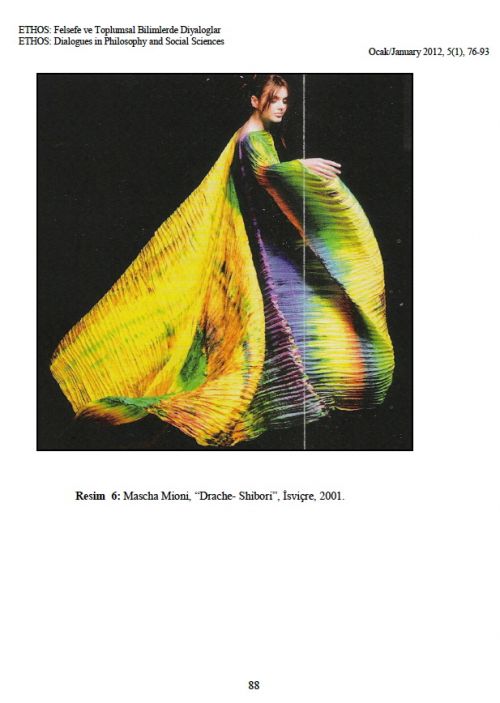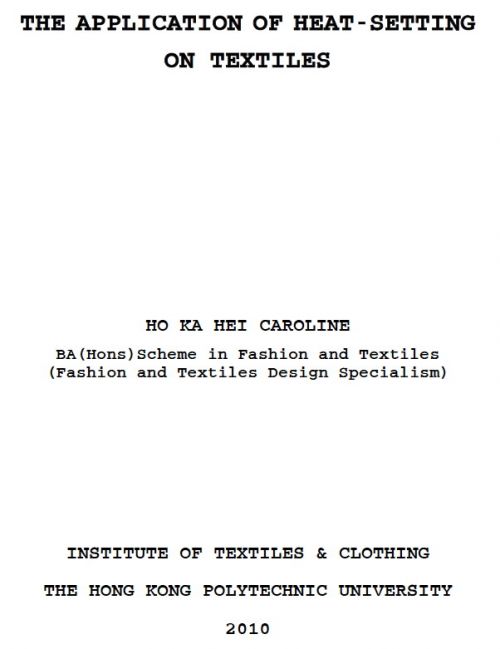

Mascha Mioni in the journal "ETHOS: Dialogues in Philosophy and Social Sciences"
Asst. Prof. at İZMİR DEMOKRASİ ÜNİVERSİTESİ, Dr. Goezde Yetmen, writes in her essay in the journal "ETHOS: Dialogues in Philosophy and Social Sciences" on Wearable Art on p. 79f:
"... For example, Miyake's work "Mutant Pleats" suggested pleats in next season's fashion design trends. (Koda, 2004, p. 93) Like Miyake's "Mutant Pleats"
Tim Harding's "Oaks", Mascha Mioni's "Drache-Shibori" and recently "Body Skin and Hair" and "Perfect Hurts" by Sandra Backlund. Its effects on designs are unquestionably accepted. (Sterk, 2005, p.29), (Duncan, 2002, p. 124)
and p. 81:
"... Many of the Wearable Artworks are to be viewed and understood as works of art, not to be worn. Today's important representatives are Jorie Johnson, Tim Harding, Mascha
Mioni, Galya Rosenfeld, Sandra Backlund. ..."
(Translated by the webmaster from the attached original Turkish essay using Google Translate)
Download PDF
go to post
Mascha Mioni im Kunstmagazin futuro - contemporaryart 2011
The foreword to the fourth art-to-wear book
In futuro - contemporaryart 2011 art critic Marianne Mittelholzer, Wangen/Zurich, Switzerland, introduces the fourth book with art-to-wear of Mascha Mioni "vor der Kamera von Carlos Rieder - Textil Art mascha mioni", and thinks about the series Phoenix contained therein.
"...textile artist Mascha Mioni has thoroughly studied kimonos. Because a kimono is never only a garment, it is always also a work of art. It is dress and picture at once..."go to post
With her textile-art Mascha Mioni helped significantly to reposition the Shibori technique
Ecaterina Ileana Bitay earned a magna cum laude on her PhD thesis: "SIMBOL SI TEHNICĂ ARHAICĂ-RAPEL IN CREAłIA CONTEMPORANA" at the Universitatea de Arta si Design Din Cluji-Napoca, Rumania. In it she studies the history of Shibori/Ikat/Batik up to today and lists on p. 12f of the English translation those artists that helped significantly to reposition the Shibori technique in the artistic field:
"…
I made an analysis of the creation and innovation activity of numerous artists in the textile field, who contributed significantly to the development of the Shibori technique and its repositioning in the artistic field.
These are: Jun’ichi Arai, Hiroshi Murase, Tsuyoshi Kuno, Trine Mauritz Eriksen, Elisa Ligon, Reiko Sudo, Jurgen Lehl, Awa Cissé, Andrea Serrahn, Yoshiko Jinzenji, Sara Chiarugi, Catharine Ellis Muerdter, Hideko Takahashi, Yuh Okano, Joan Morris, Mascha Mioni, Patricia Black, Angelina Deantonis, Issey Myake, Makiko Minagawa, Yohsi Yamamoto, Asha Sarabhai, Marian Clayden, Carter Smith, Ana Lisa Hedstrom, Carol Lee Shanks, D’Archie Beytebiere, Mike Kane, Steve Sells, Mariana Carreno, Dorita Gomien, Karren Brito, Lori Bacigalupi, Marshall Bacigalupi, Ioan Mc Gee, Mark Thomas, Genevieve Dion, Barbara Rogers, Jeung-hwa Park, Mie Iwatsubo, Héléne Soubeyran, Yoshiki Hishinuma, Hiroyuki Shindo, Yukiko Echigo, Michie Yamaguchi, Kaei Hayakawa, Keiko Amenomori – Schmeisser, Junco Sato Pollack, Joan Morris, Inge Dusi, Lynn Klein, Jean Williams Cacicedo, Marie-Héléne Guelton, Chad Alice Hagen, Judith Content, Liz Axford, Jan Myers-Newbury, Peter Wheeler, Sharon Baurley, Masae Bamba, Yuh Okano, Moira Doropoulos, Terri Fletecher, Emily Dubios, Elisa Ligon, Linda Lee Kerr, Lessley Nishigawara. "
Download PDF
go to post
Quotidiana on the exposition of Mascha Mioni & Lawrence McLaiughlin at the Gallery RdC
article and photo by Susi Rothmund in the Swiss newspaper Quotidiana
go to post
Mascha Mioni in the Bachelor thesis of Caroline Ho Ka Hei
Caroline Ho Ka Hei writes in her thesis for the Bachelor of Arts at the Institute of Textiles & Clothing of Hong Kong Polytechnic University.
p. 31/32:
"In this section, six textiles designers who are renowned for their heat-setting technique applications were studied: Ana Lisa Hedstrom, Barbara Rogers, Jean Williams Cacicedo, Jun'ichi Arai, Mascha Mioni and Tsuyoshi Kuno.
...
the reason of these six designers being studied in this project was due to their profound contribution to the development of heat-setting technique. Their exquisite art pieces raised my interest in heat-setting and thus set off this study.
p. 43-47:
"2.6.5 Mascha Mioni
Growing up in Switzerland, Mascha Mioni is a painter whose oil paintings on canvas were exhibited all over Europe. Later in 1986, as she studied dress-making, she started to develop silk paintings and design silk dresses. Her artistic dresses were shown in different places in the world, including Germany, United Kingdom, Italy and United States. Together with six other textile artists, Mioni published a series of three books “Art To Wear” from 1990 to 2005.
Fig. 2.6.5(1a) to Fig. 2.6.5(3c) show the dresses by Mioni in the exhibition “Transformation: Material˙ Magic˙ Memory”. From Fig. 2.6.5(4) to Fig. 2.6.5(7c) are some other works of Mioni.
..."
complete thesis c.f. pdf





